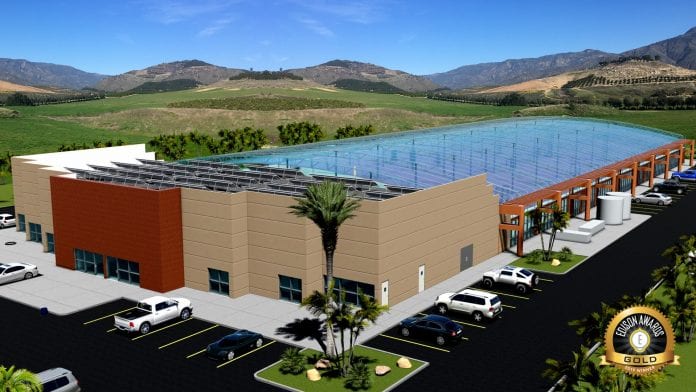
Terry Van Gelder, Chief Executive of AGT Technologies, LLC, showcases AGT’s innovative Hybrid Greenhouse.
Terry Van Gelder, Chief Executive of AGT Technologies, LLC, has 20 years’ experience in the agriculture sector, 35 years in construction; and has designed several facilities for private industry and the US military. He has now designed an eco-friendly commercially framed greenhouse for cannabis cultivation – AGT Hybrid Greenhouse – which received the Edison Innovation Award in 2019 in the Energy and Sustainability category.
He said: “Exactly like greenhouses for medical cannabis, military facilities must comply with specific and precise regulations. When I started working in greenhouses, I noticed that most of them did not meet the criteria required for all aspects of growing – even though they were for pharmaceutical crops.”
The AGT Hybrid Greenhouse has a patent-pending design which uses the cool air drawn from the earth to naturally cool and moderate the greenhouse temperature. This can significantly reduce energy consumption and bills by up to 80%. For new greenhouse constructions, this means a vastly reduced carbon footprint for cities.
How does the system work?
The system has a sealed air chamber from the roof to the ceiling, which continues down in between the inner and outer walls.
This creates a large air plenum at the roof and wall cavities which is a natural insulation barrier. The air plenum completely traps all the heat developed by the steel structure, which is the reason traditional greenhouses have microclimate zones; because of their open steel structure.
Van Gelder said: “The open steel structure has to be cooled in hot climates and warmed in cold climates, a negative use of energy. With the heat contained in the air cavity you have a precise amount of cubic feet of air to manage just like in office space.
“You have a length, width and ceiling height with no major heat variables to affect the air management system. In hot climates the trapped roof heat can be exhausted or stored underground and reused in the growing rooms. Even in cold climates, the sealed roof cavity will produce heat which can be recycled back into the growing rooms.”
Another use of the roof and wall air cavity is the air management systems. All return air flow is directed through the roof and wall cavity, so there is no need for ductwork. Heat naturally rises so there are return air vents in the ceiling, with each one of these vents utilising an oil laden filter capable of pressure washing. This is designed to kill everything from fungi, pollen, insects, and cross contamination from room to room.
A break from traditional greenhouse farming
AGT Technologies, LLC does not use traditional greenhouse framing because of long delays in receiving the product, the excessive use of small parts and the fact that most of them are proprietary.
Van Gelder said: “You have a hard time finding people to erect these structures, it’s not a common framing system in the construction industry. That is why we use commercial steel frames, for immediate availability and constructability.”
It is a framing system all commercial steel erectors know and build.
“With a commercial framing system you are not limited on weight support off the ceiling structure. These structures can support any type of roof mounted automation, water booms, lights, fire sprinkler systems, etc,” said Van Gelder.
“These structures are the same used when we build aircraft hangars for the military. Its routine to support five to 10 tonne bridge cranes directly off the ceiling structure, with no support columns. Whether you are building 50,000 or 500,000 square foot, our delivery remains at four months from production release date.
“AGT also offers an underground mechanical system because it is more efficient, especially in cold countries where dehumidifiers pull out much heat. That heat is thus put back into the heating chamber underneath the structure, or it can be exhausted if you are in a very warm environment.”
Growing challenges with conventional greenhouses
Conventional greenhouses in use today are inefficient, single-purpose and lack the security and sterile environment necessary for high value medical- or research-based growing operations. They are constructed of thin, uninsulated materials which are highly susceptible to temperate fluctuations and changes in humidity, as well as potential to infestations by pests or outside contaminants.
Heating, cooling and dehumidifying conventional greenhouses is extremely energy intensive and generates significant greenhouse gas emissions (GHG). Deployment of greenhouses is a rapidly growing sector worldwide and associated GHG emissions are expected to significantly increase, driven by growing demand for high value and experimental plant operations, including bio algae research, cannabis, new plant hybrids and more.
AGT Hybrid Greenhouses
Key features of the AGT Hybrid Greenhouses include:
- Optimised lighting: the optimisation of natural light, elevated platforms topped with a reflective coating to amplify natural daylighting, while transparent divider walls and doors help minimise shading and maximise energy efficiency;
- Readily available and made from recycled materials: ready to ship framing can guarantee greenhouse delivery within four months and includes up to 85% recycled materials, significantly exceeding the California Green Building code;
- Improved insulation: the dual pane design creates an energy efficient, standalone sealed air cavity, which is located between the roof and ceiling and continues down into the vertical wall cavity to provide insulation. Intake air is drawn from a perforated underground pipe system for natural, renewable air filtration, cooling, and heating;
- Title 24 compliance: the energy efficiency levels meet California standards for conditioned non-residential buildings, support green building certifications and make climate smart agriculture a reality;
- Natural earth air system: the mechanical system is located underground to utilise the natural earth’s ambient temperatures of 55 to 60 degrees to cool or warm the air depending on the outdoor climate;
- Cleanroom technology: A sealed, cleanroom laboratory environment with variable daylighting control provides a sterile setting for research and testing. All air flow is managed by oil bath fans, which contains a series of oil laden filters and traps to eliminate airborne contaminates and odours;
- Fully customisable: optional features include: natural wind movement; adjustable artificial light source; refractor panels; electronic glazing daylighting control; cloud cover hazing in sealed air cavity; louvre daylighting control; and draping daylighting control. Recessed blackout curtains do not block off fire sprinkler systems when activated;
- Infinitely versatile: due to their modern exterior architecture, security and durability, AGT Hybrid Greenhouses can be easily repurposed should an entity cease its grow operations. Potential applications for a repurposed greenhouse include office space, sports and recreation facilities, fitness centres and gyms, entertainment facilities; and warehouses or manufacturing bases;
- Cost effective: reducing energy use by up to 80% enables a 3-year payback period;
- Guaranteed four-month greenhouse delivery manufacturing by Blue Scope Steel;
- Walkable transparent roofs with OSHA-mandated fall-through protection for transparent panels; and
- 50-state licensed contracting and A/E services by Blue Scope Construction.
CRAM: onsite electrical power generation
To further reduce energy costs and emissions, AGT Technologies, LLC has developed a Counter Rotating Alternator Motor (CRAM) that helps generate additional onsite energy in order to directly provide power or provide energy storage. The CRAM combines both an electric motor, which spins clockwise; and an electric generator spinning anticlockwise.
The system creates sufficient onsite electrical power to maintain the electric motor speed, while producing excess electric power that can be generated 24/7 and can help provide backup energy storage or be utilised directly to power the facility. The CRAM can be part of an integrated net zero system powered by onsite solar or wind energy, or it can use to dramatically increase energy efficiency onsite.
About AGT Technologies, LLC
AGT Technologies, LLC, headquartered in California, has over 35 years of active building innovation and contracting with deep roots in the agricultural industry. AGT has designed, constructed and renovated buildings for private and public entities, including the US military.
AGT Technologies, LLC has recently emerged as a leader in advanced building design with the AGT Hybrid Greenhouse system and its associated renewable energy technologies.
Terry Van Gelder
Chief Executive
AGT Technologies, LLC
+1 866 440 2798
terry@adctech.us
LinkedIn
www.agtgreenhouse.com
This article will appear in the second issue of Medical Cannabis Network which is out in April. Click here to get your free subscription today.


















